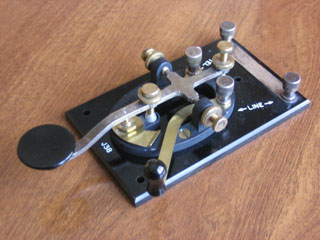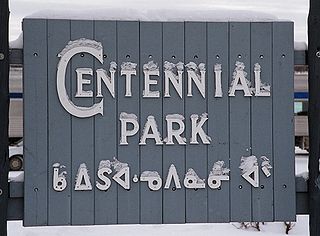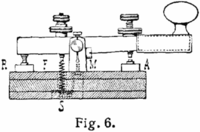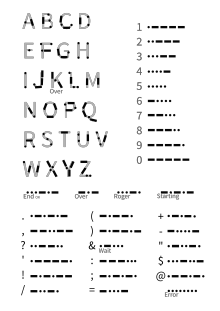
An abugida – sometimes also called alphasyllabary, neosyllabary, or pseudo-alphabet – is a segmental writing system in which consonant–vowel sequences are written as units; each unit is based on a consonant letter, and vowel notation is secondary, similar to a diacritical mark. This contrasts with a full alphabet, in which vowels have status equal to consonants, and with an abjad, in which vowel marking is absent, partial, or optional – in less formal contexts, all three types of the script may be termed "alphabets". The terms also contrast them with a syllabary, in which a single symbol denotes the combination of one consonant and one vowel.

A diacritic is a glyph added to a letter or to a basic glyph. The term derives from the Ancient Greek διακριτικός, from διακρίνω. The word diacritic is a noun, though it is sometimes used in an attributive sense, whereas diacritical is only an adjective. Some diacritics, such as the acute ⟨á⟩, grave ⟨à⟩, and circumflex ⟨â⟩, are often called accents. Diacritics may appear above or below a letter or in some other position such as within the letter or between two letters.

Morse code is a method used in telecommunication to encode text characters as standardized sequences of two different signal durations, called dots and dashes, or dits and dahs. Morse code is named after Samuel Morse, one of the early developers of the system adopted for electrical telegraphy.
The Standard Arabic Technical Transliteration System, commonly referred to by its acronym SATTS, is a system for writing and transmitting Arabic language text using the one-for-one substitution of ASCII-range characters for the letters of the Arabic alphabet. Unlike more common systems for transliterating Arabic, SATTS does not provide the reader with any more phonetic information than standard Arabic orthography does; that is, it provides the bare Arabic alphabetic spelling with no notation of short vowels, doubled consonants, etc. In other words, it is intended as a transliteration tool for Arabic linguists, and is of limited use to those who do not know Arabic.

A mnemonic device or memory device is any learning technique that aids information retention or retrieval in the human memory, often by associating the information with something that is easier to remember.
The acute accent, ◌́, is a diacritic used in many modern written languages with alphabets based on the Latin, Cyrillic, and Greek scripts. For the most commonly encountered uses of the accent in the Latin and Greek alphabets, precomposed characters are available.

A telegraph key or Morse key is a specialized electrical switch used by a trained operator to transmit text messages in Morse code in a telegraphy system. Keys are used in all forms of electrical telegraph systems, including landline telegraphy and radio telegraphy. An operator uses the telegraph key to send electrical pulses of two different lengths: short pulses, called dots or dits, and longer pulses, called dashes or dahs. These pulses encode the letters and other characters that spell out the message.
A ring diacritic may appear above or below letters. It may be combined with some letters of the extended Latin alphabets in various contexts.
Khmer script is an abugida (alphasyllabary) script used to write the Khmer language, the official language of Cambodia. It is also used to write Pali in the Buddhist liturgy of Cambodia and Thailand.
Piphilology comprises the creation and use of mnemonic techniques to remember many digits of the mathematical constant π. The word is a play on the word "pi" itself and of the linguistic field of philology.

Canadian syllabic writing, or simply syllabics, is a family of writing systems used in a number of Indigenous Canadian languages of the Algonquian, Inuit, and (formerly) Athabaskan language families. These languages had no formal writing system previously. They are valued for their distinctiveness from the Latin script and for the ease with which literacy can be achieved. For instance, by the late 19th century the Cree had achieved what may have been one of the highest rates of literacy in the world.

Japanese Braille is the braille script of the Japanese language. It is based on the original braille script, though the connection is tenuous. In Japanese it is known as tenji (点字), literally "dot characters". It transcribes Japanese more or less as it would be written in the hiragana or katakana syllabaries, without any provision for writing kanji.

Ojibwe is an indigenous language of North America from the Algonquian language family. Ojibwe is one of the largest Native American languages north of Mexico in terms of number of speakers and is characterized by a series of dialects, some of which differ significantly. The dialects of Ojibwe are spoken in Canada from southwestern Quebec, through Ontario, Manitoba and parts of Saskatchewan, with outlying communities in Alberta and British Columbia, and in the United States from Michigan through Wisconsin and Minnesota, with a number of communities in North Dakota and Montana, as well as migrant groups in Kansas and Oklahoma.

Procedural signs or prosigns are shorthand signals used in Morse code telegraphy, for the purpose of simplifying and standardizing procedural protocols for landline and radio communication. The procedural signs are distinct from conventional Morse code abbreviations, which consist mainly of brevity codes that convey messages to other parties with greater speed and accuracy. However, some codes are used both as prosigns and as single letters or punctuation marks, and for those, the distinction between a prosign and abbreviation is ambiguous, even in context.

The Russian Morse code approximates the Morse code for the Latin alphabet. It was enacted by the Russian government in 1856.

A writing system comprises a particular set of symbols, called a script, as well as the rules by which the script represents a particular language. Writing systems can generally be classified according to how symbols function according to these rules, with the most common types being alphabets, syllabaries, and logographies. Alphabets use symbols called letters that correspond to spoken phonemes. Abjads generally only have letters for consonants, while pure alphabets have letters for both consonants and vowels. Abugidas use characters that correspond to consonant–vowel pairs. Syllabaries use symbols called syllabograms to represent syllables or moras. Logographies use characters that represent semantic units, such as words or morphemes.
ISO 11940-2 is an ISO standard for a simplified transcription of the Thai language into Latin characters.
In CW Morse code operations, QSK or full break-in operation describes an operating mode in which the transmitting station can detect signals from other stations between the elements or letters of the Morse transmission. This allows other stations to interrupt the transmitting station between individual coding elements, and such allows for a conversational style of communication.
E is a vowel of Indic abugidas. In modern Indic scripts, E is derived from the early "Ashoka" Brahmi letter after having gone through the Gupta letter . As an Indic vowel, E comes in two normally distinct forms: 1) as an independent letter, and 2) as a vowel sign for modifying a base consonant. Bare consonants without a modifying vowel sign have the inherent "A" vowel.













